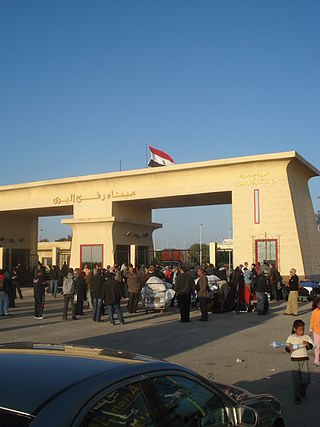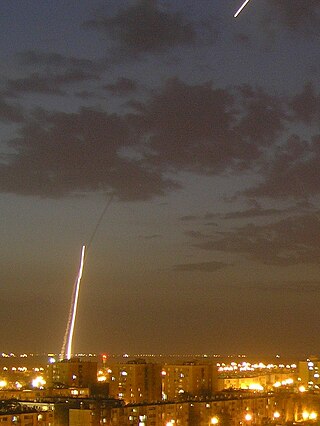Related Research Articles

The Gaza Strip, or simply Gaza, is a polity and the smaller of the two Palestinian territories. On the eastern coast of the Mediterranean Sea, Gaza is bordered by Egypt on the southwest and Israel on the east and north.

Netzarim was an Israeli settlement in the Gaza Strip about 5 kilometers southwest of Gaza City. It was established in 1972. In August 2005, the inhabitants of Netzarim were evicted by the Israel Defense Forces (IDF) as part of Israel's unilateral disengagement plan.

The state of human rights in the West Bank and Gaza Strip is determined by Palestinian as well as Israeli policies, which affect Palestinians in the occupied Palestinian territories both directly and indirectly, through their influence over the Palestinian Authority (PA). Based on The Economist Democracy Index this state is classified as an authoritarian regime.

The Rafah Border Crossing or Rafah Crossing Point is the sole crossing point between Egypt and Palestine's Gaza Strip. It is located on the Egypt–Palestine border. Under a 2007 agreement between Egypt and Israel, Egypt controls the crossing but imports through the Rafah crossing require Israeli approval.

The Erez Crossing, also known as the Beit Hanoun Crossing, is a border crossing between the Gaza Strip and Israel. It is located at the northern end of the Gaza Strip, between the Israeli kibbutz of Erez and the Palestinian town of Beit Hanoun.
The future of Palestinian prisoners detained by Israel in the context of the Israeli–Palestinian conflict is considered central to progress in the Israeli–Palestinian peace process. Cases of prison sentences include the charges of terrorism or being a member of an "illegal terrorist organization", such as Hamas or prior to the Oslo Accords the Palestine Liberation Organization, but according to some accounts also by political activism such as raising a Palestinian flag.

A blockade has been imposed on the movement of goods and people in and out of the Gaza Strip following Hamas's takeover in 2007, led by Israel and supported by Egypt. The blockade's current stated aim is to prevent the smuggling of weapons into Gaza, although previously stated motivations have included exerting economic pressure on Hamas. Human rights groups have described the blockade as illegal and a form of collective punishment as it restricts the flow of essential goods, contributes to economic hardship, and limits the freedom of movement for Gaza's residents. The blockade and its effects have led to the territory being described as an "open-air prison".

The Gaza War, also known as Operation Cast Lead, also known as the Gaza Massacre, and referred to as the Battle of al-Furqan by Hamas, was a three-week armed conflict between Gaza Strip Palestinian paramilitary groups and the Israel Defense Forces (IDF) that began on 27 December 2008 and ended on 18 January 2009 with a unilateral ceasefire. The conflict resulted in 1,166–1,417 Palestinian and 13 Israeli deaths. Over 46,000 homes were destroyed in Gaza, making more than 100,000 people homeless.

The economy of the Gaza Strip was dependent on small industries and agriculture. After years of decline, the Gaza economy experienced some growth in the late 2000s, boosted by foreign aid. According to the International Monetary Fund, the economy grew 20 percent in 2011, and the per capita gross domestic product increased by 19 percent.

In November 2012, the Israel Defense Forces (IDF) launched Operation Pillar of Defense, which was an eight-day campaign in the Hamas-governed Gaza Strip, beginning on 14 November 2012 with the killing of Ahmed Jabari, chief of the Gaza military wing of Hamas, by an Israeli airstrike.

The governance of the Gaza Strip since the Hamas takeover of the Gaza Strip in June 2007 has been carried out by Hamas. The Hamas government in Gaza was led by Ismail Haniyeh from 2007 until February 2017, when Haniyeh was replaced as leader of Hamas in the Gaza Strip by Yahya Sinwar. As of November 2023, Yahya Sinwar continues to be the leader of Hamas in the Gaza Strip. Due to the ongoing Israel–Hamas war, Hamas lost control of most of the northern part of the Gaza Strip.

Restrictions on the movement of Palestinians in the Israeli-occupied territories by Israel is an issue in the Israeli–Palestinian conflict. According to B'Tselem, following the 1967 war, the occupied territories were proclaimed closed military zones. In 1972, general exit orders were issued allowing residents of those territories to move freely between the West Bank, Israel and the Gaza Strip. Following the First Intifada by 1991, the general exit orders were revoked, and personal exit permits were required. According to B'Tselem, a measure of overall closure of the territories was enacted for the first time in 1993, and would result in total closures following rises in Palestinian political violence.

The 2014 Gaza War, also known as Operation Protective Edge, and Battle of the Withered Grain, was a military operation launched by Israel on 8 July 2014 in the Gaza Strip, a Palestinian territory that has been governed by Hamas since 2007. Following the kidnapping and murder of three Israeli teenagers in the West Bank by Hamas-affiliated Palestinian militants, the Israel Defense Forces (IDF) initiated Operation Brother's Keeper, in which some 350 Palestinians, including nearly all of the active Hamas militants in the West Bank, were arrested. Hamas subsequently fired a greater number of rockets into Israel from the Gaza Strip, triggering a seven-week-long conflict between the two sides. It was one of the deadliest outbreaks of open conflict between Israel and the Palestinians in decades. The combination of Palestinian rocket attacks and Israeli airstrikes resulted in over two thousand deaths, the vast majority of which were Gazan Palestinians. This includes a total of six Israeli civilians who were killed as a result of the conflict.
Palestinian workers in Israel are Palestinian citizens of the Palestinian Authority who are employed by Israeli citizens in the State of Israel and Israeli settlements in the West Bank. Most of them work as unskilled laborers in sectors such as agriculture and construction.

The Israeli permit regime in the West Bank is the legal regime that requires Palestinians to obtain a number of separate permits from the Israeli military authorities governing Palestinians in the Israeli-occupied West Bank for a wide range of activities. The first military order requiring permits for the Palestinians was issued before the end of the 1967 Six-Day War. The two uprisings of 1987 and 2001 were met by increased security measures, differentiation of IDs into green and red, policies of village closures, curfews and more stringent restrictions on Palestinian movement, with the general exit permit of 1972 replaced by individual permits. The stated Israeli justification for this new permit regime regarding movements was to contain the expansion of the uprisings and protect both the IDF and Israeli civilians from military confrontations with armed Palestinians. The regime has since expanded to 101 different types of permits covering nearly every aspect of Palestinian life, governing movement in Israel and in Israeli settlements, transit between Gaza and the West Bank, movement in Jerusalem and the seam zone, and travel abroad via international borders. The Israeli High Court has rejected petitions against the permit regime, allowing that it severely impinges on the rights of Palestinian residents but that the harm was proportionate.

Rami Aman is a Palestinian journalist and peace activist in the Gaza Strip. Aman founded the Gaza Youth Committee, through which since 2015 Aman has been organizing small-scale video chats between Israelis and Palestinian peace activists in the Gaza Strip in an initiative called "Skype With Your Enemy." On 9 April 2020, Aman was arrested by Hamas at the Internal Security headquarters in Gaza City. He was charged with "weakening revolutionary spirit" for his role in organizing the April 2020 video call with Israelis. He was released in October 2020.

Since the outbreak of the Israel–Hamas war on October 7, 2023, Israel has carried out mass arrests and detentions of Palestinians. Thousands have been arrested in the Israeli-occupied Palestinian territories and in Israel, based on alleged militant activity, offensive social media postings, or arbitrarily.
NGOs and human rights groups have alleged violence against Palestinian journalists for decades. Hamas, Islamic Jihad, Palestinian Authority (PA), the IDF, and others have all been accused of utilizing violence against Palestinian journalists, which has resulted in Palestine being ranked 156th out of 180 countries in the 2023 Reporters Without Borders' Press Freedom Index. Freedom House has stated that in both the West Bank and Gaza Strip, journalists are surveilled and threatened by both Palestinian and Israeli authorities. In 2022, the Palestinian Center for Development and Media Freedom found 605 violations against media freedom, with 69% attributed to the Israeli Occupation.
References
Citations
- ↑ Roth-Rowland 2023.
- 1 2 3 4 5 Akram & McNeil 2022.
- ↑ Fabian 2022.
- ↑ Shotter 2022.
- ↑ Sella 2023.
- ↑ Fabian, Emanuel. "Israel okays 1,500 more entry permits for Gaza workers, bringing total to 17,000". www.timesofisrael.com. Retrieved 15 October 2023.
- ↑ Al-Mughrabi, Nidal (28 September 202). "Israel reopens Gaza crossings, lets Palestinians back to work after two weeks". Reuters .
- ↑ Shamir 2023.
- ↑ Berger & Taha 2023.
- ↑ Pacchiani 2023.
- ↑ Nobani 2023.
Sources
- Akram, Fares; McNeil, Sam (26 August 2022). "Work permits are a lifeline for Gaza, and a lever for Israel". AP News . Retrieved 23 October 2023.
- Berger, Miriam; Taha, Sufian (16 October 2023). "For Gazan workers stranded in Israel, being apart from family is agony". The Washington Post . Archived from the original on 17 October 2023. Retrieved 23 October 2023.
- Fabian, Emanuel (22 September 2022). "Israel okays 1,500 more entry permits for Gaza workers, bringing total to 17,000". The Times of Israel . Retrieved 23 October 2023.
- Nobani, Ayman (12 October 2023). "Israel detains, expels to West Bank hundreds of Gaza Palestinian workers". Al Jazeera . Retrieved 23 October 2023.
- Pacchiani, Gianluca (23 October 2023). "Unable to return to Gaza, hundreds of laborers detained by IDF in the West Bank". The Times of Israel . Retrieved 23 October 2023.
- Roth-Rowland, Natasha (25 August 2023). "Unprotected, Gaza laborers suffer under Israel's permit regime". +972 Magazine .
- Sella, Adam (26 May 2023). "How Israel's Work Permit Policy for Palestinians Helps Maintain the Occupation". Haaretz . Archived from the original on 26 May 2023. Retrieved 23 October 2023.
- Shamir, Jonathan (19 October 2023). "Gazan Workers Stuck in Purgatory After Israel Revokes Permits". Jewish Currents . Retrieved 23 October 2023.
- Shotter, James (17 October 2022). "Israeli work permits offer slight relief to 'exhausted' Gaza economy". Financial Times . Archived from the original on 17 October 2022.